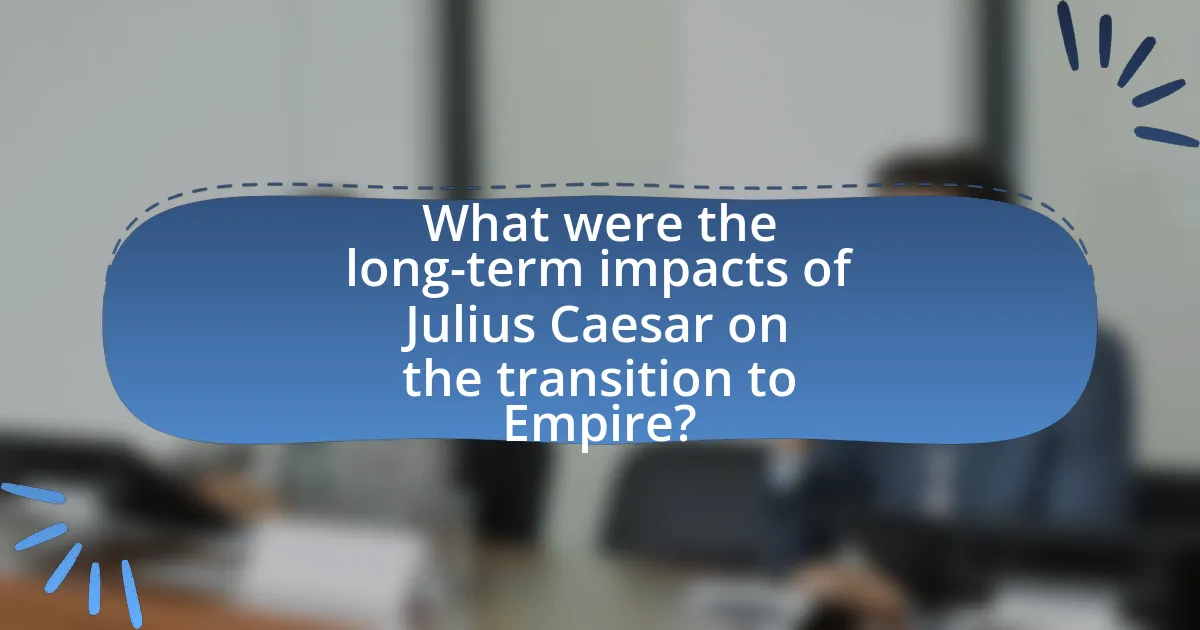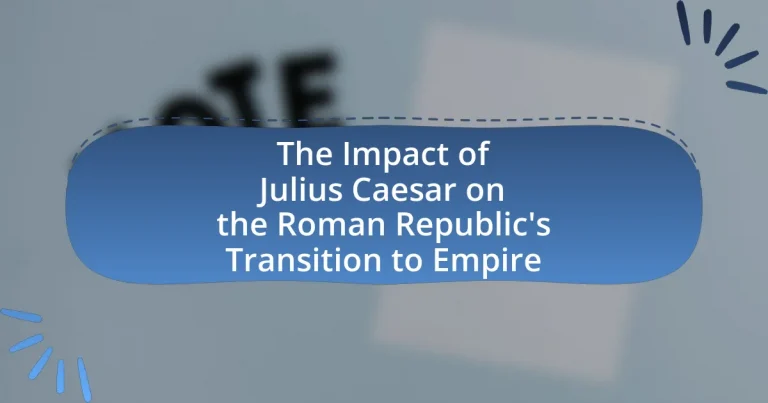Julius Caesar was a central figure in the transformation of the Roman Republic into the Roman Empire, significantly altering its political landscape through military conquests, political alliances, and reforms. His rise to power was marked by key events such as his military campaigns in Gaul and the formation of the First Triumvirate, which enhanced his influence. Caesar’s reforms, including the introduction of the Julian calendar and land redistribution, challenged traditional power structures and centralized authority, ultimately leading to his appointment as dictator for life. His assassination in 44 BCE created a power vacuum that precipitated civil wars and the eventual establishment of the Roman Empire under Augustus, highlighting the long-term implications of his actions on governance and political stability.

What was the role of Julius Caesar in the Roman Republic?
Julius Caesar played a pivotal role in the Roman Republic by transforming its political landscape and paving the way for the establishment of the Roman Empire. As a military general and statesman, he expanded Roman territories through conquests, notably in Gaul, which significantly increased his power and popularity. His crossing of the Rubicon River in 49 BCE initiated a civil war, leading to his appointment as dictator for life in 44 BCE. This concentration of power undermined the traditional republican governance and contributed to the eventual transition from a republic to an imperial system. Caesar’s reforms, including the reorganization of the calendar and land redistribution, further solidified his influence, demonstrating his critical role in the Republic’s evolution.
How did Julius Caesar rise to power within the Roman Republic?
Julius Caesar rose to power within the Roman Republic through a combination of military success, political alliances, and populist reforms. His military conquests, particularly in Gaul from 58 to 50 BCE, expanded Rome’s territory and increased his popularity among the Roman populace and soldiers. Caesar formed the First Triumvirate in 60 BCE with Pompey and Crassus, which allowed him to gain significant political influence. Additionally, his reforms, such as land redistribution and debt relief, garnered support from the lower classes. These factors culminated in his crossing of the Rubicon River in 49 BCE, which initiated a civil war and ultimately led to his dictatorship, marking a pivotal shift in the Roman political landscape.
What key events marked Caesar’s early political career?
Julius Caesar’s early political career was marked by several key events, including his election as quaestor in 69 BCE, his role as aedile in 65 BCE, and his election to the praetorship in 62 BCE. As quaestor, he managed public finances in the province of Hispania, which established his reputation for financial acumen. His tenure as aedile involved organizing public games and building projects, enhancing his popularity among the Roman populace. Finally, as praetor, he gained judicial authority and further solidified his political influence, setting the stage for his later rise to power. These events collectively contributed to his growing prominence in Roman politics and laid the groundwork for his eventual leadership.
How did military conquests contribute to Caesar’s influence?
Military conquests significantly enhanced Julius Caesar’s influence by expanding Roman territory and increasing his personal power. Through campaigns in Gaul from 58 to 50 BCE, Caesar not only secured vast lands but also amassed immense wealth and resources, which he used to bolster his political position in Rome. His victories, such as the decisive Battle of Alesia in 52 BCE, showcased his military prowess and garnered him popular support among the Roman populace and his troops. This popularity translated into political capital, allowing him to challenge the traditional senatorial authority and ultimately leading to his pivotal role in the transition of the Roman Republic to an imperial structure.
What were the political reforms initiated by Julius Caesar?
Julius Caesar initiated several significant political reforms that transformed the Roman Republic. He implemented the Julian calendar, which reformed the Roman calendar system by introducing a 365-day year with a leap year every four years, enhancing timekeeping accuracy. Additionally, Caesar expanded the Senate from 600 to 900 members, aiming to include more representatives from the provinces, thereby increasing regional representation in governance. He also enacted land reforms, redistributing public land to veterans and the poor, which aimed to alleviate economic disparities. Furthermore, Caesar centralized the bureaucracy by appointing governors and officials loyal to him, diminishing the power of the traditional senatorial class. These reforms collectively contributed to the shift from a republic to a more autocratic form of governance, laying the groundwork for the future Roman Empire.
How did Caesar’s reforms challenge the traditional power structures?
Caesar’s reforms challenged traditional power structures by centralizing authority and diminishing the influence of the Senate. He implemented measures such as the redistribution of land to veterans and the expansion of the Senate with his supporters, which undermined the established aristocratic dominance. Additionally, his appointment as dictator for life in 44 BCE concentrated power in his hands, effectively sidelining the Senate’s role in governance. These actions disrupted the balance of power that had characterized the Roman Republic, leading to increased tensions and ultimately contributing to the Republic’s transition to an imperial system.
What impact did these reforms have on the governance of Rome?
The reforms implemented by Julius Caesar significantly centralized power in the governance of Rome. By reducing the influence of the Senate and increasing the authority of the executive branch, Caesar transformed the political landscape, paving the way for the eventual establishment of the Roman Empire. His introduction of the Julian calendar and land reforms also aimed to stabilize the economy and improve civic engagement, further consolidating his control. These changes diminished the traditional republican structures, leading to a shift from a collective governance model to one dominated by a singular leader, which ultimately set the stage for the rise of imperial rule.
How did Julius Caesar’s actions lead to the end of the Roman Republic?
Julius Caesar’s actions directly led to the end of the Roman Republic by consolidating power and undermining traditional republican institutions. His crossing of the Rubicon River in 49 BCE initiated a civil war, defying the Senate’s authority and signaling a shift from collective governance to autocratic rule. Following his victory, Caesar was appointed dictator for life, effectively dismantling the checks and balances that characterized the Republic. His reforms, including land redistribution and the centralization of power, alienated the Senate and traditional elites, culminating in his assassination in 44 BCE. This act of violence further destabilized the Republic, leading to a series of civil wars that ultimately resulted in the establishment of the Roman Empire under Augustus.
What were the consequences of Caesar’s dictatorship?
Caesar’s dictatorship led to significant political and social upheaval in Rome, ultimately contributing to the end of the Roman Republic and the rise of the Roman Empire. His concentration of power undermined traditional republican institutions, as he bypassed the Senate and enacted reforms that centralized authority in his hands. This shift incited fear among senators, leading to his assassination in 44 BCE, which further destabilized the political landscape. The power vacuum created by his death resulted in a series of civil wars, culminating in the establishment of Augustus as the first emperor, marking the definitive transition from republic to empire.
How did Caesar’s concentration of power affect the Senate?
Caesar’s concentration of power significantly diminished the Senate’s authority and influence. By centralizing decision-making and bypassing traditional senatorial processes, he effectively marginalized the Senate’s role in governance. For instance, Caesar’s appointment as dictator perpetuo (dictator for life) in 44 BCE allowed him to enact policies without senatorial approval, leading to a decline in the Senate’s legislative power. This shift contributed to the erosion of the Republic’s political structure, as the Senate became increasingly seen as a rubber-stamp institution rather than a governing body with real authority.
What role did public perception play in Caesar’s rise and fall?
Public perception significantly influenced Julius Caesar’s rise and fall by shaping his political power and legacy. During his ascent, Caesar cultivated a favorable image through military successes, public reforms, and populist policies, which garnered widespread support among the Roman populace. His victories in Gaul, for instance, were celebrated in Rome, enhancing his reputation and allowing him to present himself as a champion of the people against the Senate’s elite. However, as he accumulated power and declared himself dictator for life, public perception shifted, leading to fears of tyranny among the Senate and the aristocracy. This shift culminated in his assassination in 44 BCE, driven by the belief that he threatened the Republic’s traditional values and governance. Thus, public perception was pivotal in both elevating Caesar to prominence and ultimately contributing to his downfall.
Why was Julius Caesar assassinated, and what were the implications?
Julius Caesar was assassinated primarily due to fears among Roman senators that he was accumulating too much power and threatening the Republic’s democratic traditions. His appointment as dictator perpetuo (dictator for life) in 44 BCE alarmed many, leading to a conspiracy among senators, including Brutus and Cassius, who believed that killing him would restore the Republic. The implications of his assassination were profound; it led to a power vacuum, civil wars, and ultimately the rise of his adopted heir, Octavian, who became Augustus, marking the transition from the Roman Republic to the Roman Empire. This shift fundamentally altered the governance of Rome, concentrating power in the hands of a single ruler and ending centuries of republican governance.
Who were the key figures involved in the conspiracy against Caesar?
The key figures involved in the conspiracy against Julius Caesar were Gaius Cassius Longinus, Marcus Junius Brutus, and Decimus Junius Brutus Albinus. Gaius Cassius Longinus was a leading instigator of the plot, motivated by a desire to restore the Roman Republic. Marcus Junius Brutus, a close friend of Caesar, was persuaded to join the conspiracy due to his belief that Caesar’s power threatened the Republic. Decimus Junius Brutus Albinus, another conspirator, played a crucial role in luring Caesar to the Senate on the Ides of March, where the assassination took place. These individuals collectively orchestrated the assassination, which marked a pivotal moment in the transition of the Roman Republic towards imperial rule.
How did Caesar’s assassination contribute to the power vacuum in Rome?
Caesar’s assassination in 44 BCE created a significant power vacuum in Rome by eliminating a central figure who had consolidated power and authority. His death led to a struggle among various factions, including supporters of Caesar and those opposed to his rule, which destabilized the political landscape. The absence of a strong leader resulted in civil wars, as rival generals like Mark Antony and Octavian vied for control, ultimately leading to the end of the Roman Republic and the rise of the Empire. This turmoil was marked by the power struggles that ensued, demonstrating how the removal of a pivotal leader can disrupt governance and create chaos in a political system.

What were the long-term impacts of Julius Caesar on the transition to Empire?
Julius Caesar’s long-term impacts on the transition to Empire included the centralization of power and the erosion of the Republican system. His crossing of the Rubicon in 49 BCE initiated a civil war that ultimately led to his dictatorship, which set a precedent for future leaders to consolidate authority. The reforms he implemented, such as the expansion of the Senate and land redistribution, weakened traditional Republican checks and balances. Following his assassination in 44 BCE, the power struggles that ensued culminated in the rise of Augustus, marking the definitive shift from Republic to Empire. This transition was characterized by the establishment of imperial authority, which fundamentally altered the governance of Rome and paved the way for a centralized autocratic rule.
How did Caesar’s legacy influence his successors?
Caesar’s legacy significantly influenced his successors by establishing a model of centralized power and military authority that they sought to emulate. His accumulation of power, particularly through the title of dictator for life, set a precedent for future leaders like Augustus, who consolidated power while maintaining the facade of republican governance. Augustus, for instance, adopted many of Caesar’s reforms, including the expansion of the Senate and the establishment of a standing army, which were crucial in transitioning the Roman Republic into an empire. Additionally, Caesar’s assassination highlighted the volatility of political power, prompting successors to adopt more autocratic measures to secure their positions and prevent similar fates. This shift towards autocracy and the emphasis on military loyalty became defining characteristics of subsequent emperors, fundamentally altering the governance of Rome.
What changes did Augustus implement in response to Caesar’s rule?
Augustus implemented significant changes in governance and administration in response to Julius Caesar’s rule, primarily by establishing a more centralized and stable form of government. He transitioned Rome from a republic to an imperial system, consolidating power under the title of Princeps, which allowed him to maintain the facade of republican governance while exercising autocratic control. Augustus reformed the Senate by reducing its size and increasing its authority in certain areas, thereby ensuring loyalty and stability. He also initiated social and moral reforms, including laws to promote family values and increase the birthrate among the Roman elite, reflecting a shift towards a more controlled society. These changes were aimed at preventing the chaos and civil strife that characterized the late republic during Caesar’s time, ultimately laying the foundation for the Roman Empire.
How did Caesar’s actions set the stage for the establishment of the Roman Empire?
Caesar’s actions, particularly his crossing of the Rubicon River in 49 BCE, directly challenged the authority of the Roman Senate and initiated a civil war, which destabilized the Roman Republic. This pivotal moment marked the beginning of a series of events that led to the end of the Republic and the rise of imperial rule. His subsequent victory in the civil war allowed him to consolidate power, effectively becoming the dictator of Rome. Additionally, Caesar implemented significant reforms, such as the reorganization of the calendar and land redistribution, which garnered popular support and weakened the traditional senatorial elite. These actions created a power vacuum and set a precedent for future leaders, notably Augustus, who would ultimately establish the Roman Empire.
What lessons can be learned from Julius Caesar’s impact on governance?
Julius Caesar’s impact on governance teaches the importance of strong leadership and the risks of concentrating power. His centralization of authority, exemplified by his appointment as dictator for life in 44 BCE, demonstrated how effective leadership can stabilize a state but also how it can lead to tyranny and civil unrest. The subsequent assassination of Caesar by senators illustrates the dangers of perceived autocracy and the potential backlash from political elites. This historical context emphasizes the need for checks and balances in governance to prevent the rise of dictatorial power while ensuring effective leadership.
How can modern leaders apply Caesar’s strategies and mistakes?
Modern leaders can apply Julius Caesar’s strategies by emphasizing decisive action, effective communication, and adaptability while learning from his mistakes, such as overreliance on personal loyalty and neglecting broader political alliances. Caesar’s ability to swiftly mobilize troops and execute military strategies demonstrates the importance of decisiveness in leadership. His communication skills, particularly in rallying support among diverse groups, highlight the need for leaders to engage effectively with their teams. However, Caesar’s downfall illustrates the risks of prioritizing personal loyalty over institutional stability, reminding leaders to cultivate a balanced approach that includes building alliances and fostering collaboration. By integrating these lessons, modern leaders can enhance their effectiveness while avoiding the pitfalls that led to Caesar’s demise.
What are the implications of power consolidation in contemporary politics?
Power consolidation in contemporary politics often leads to the erosion of democratic institutions and increased authoritarianism. This trend is evidenced by the rise of leaders who centralize authority, undermining checks and balances that are essential for a functioning democracy. For instance, in countries like Hungary and Turkey, leaders have enacted reforms that diminish judicial independence and curtail media freedom, which are critical for accountability and transparency. Such implications can result in weakened civil liberties, reduced political pluralism, and the potential for political instability, as seen in various nations where power has become overly concentrated.


